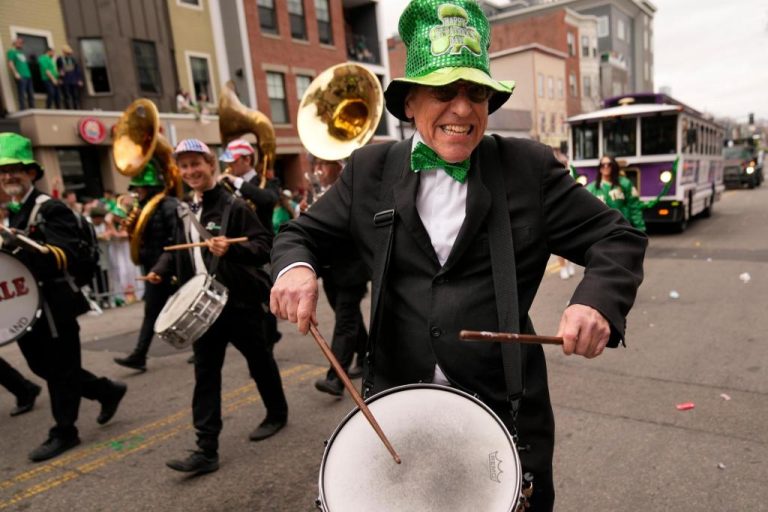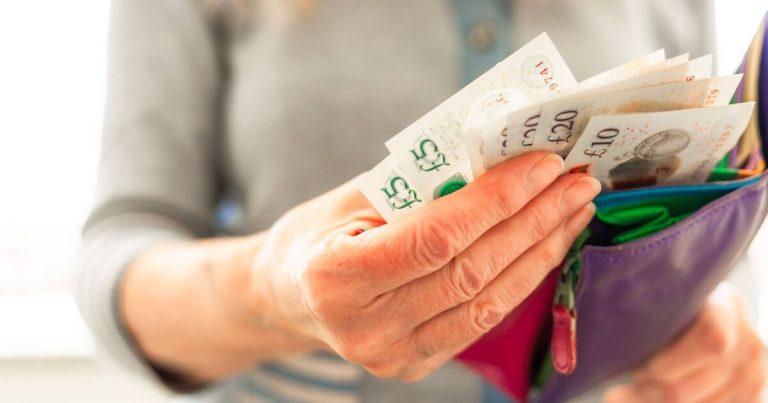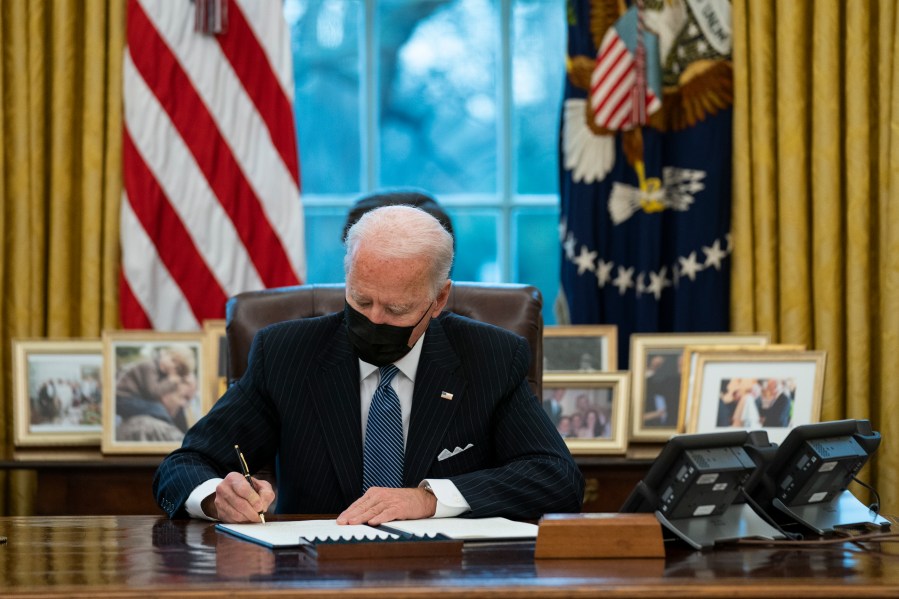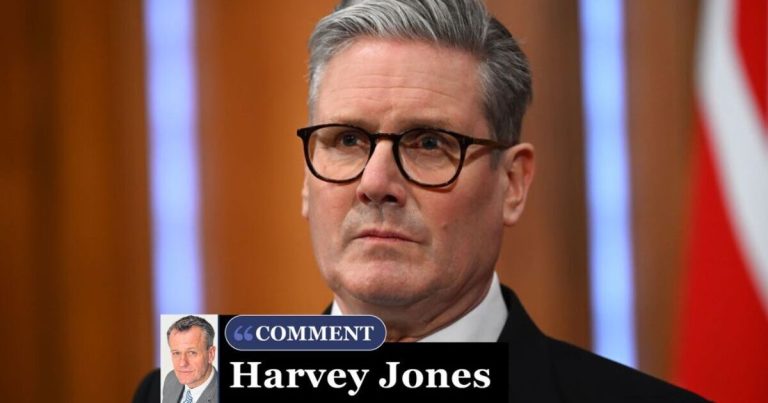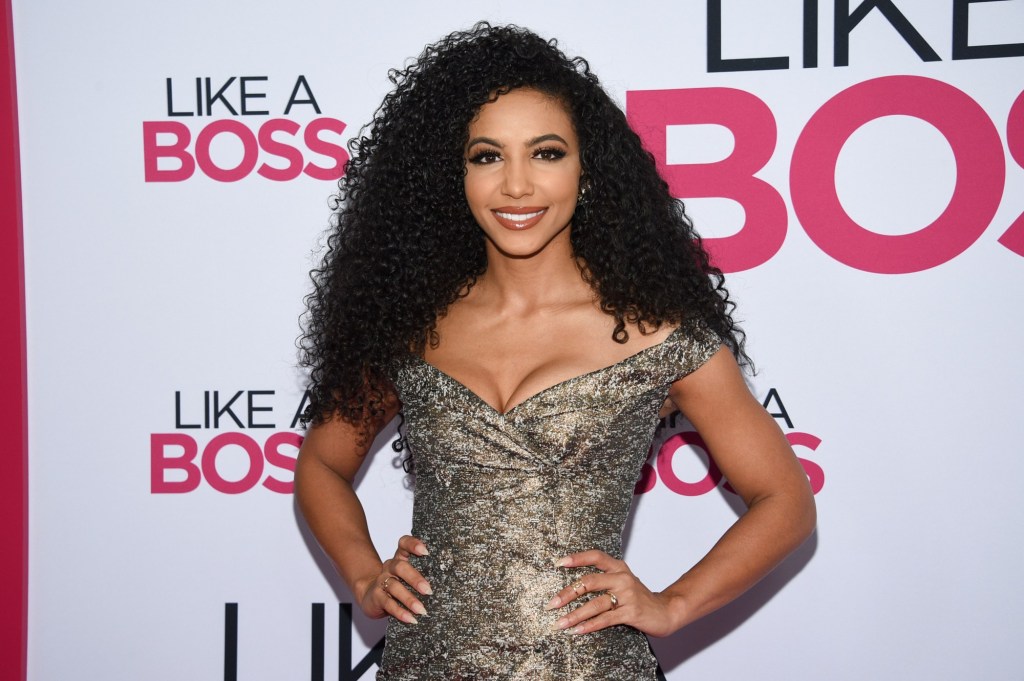
By Amber Ferguson
The Washington Post
FORT MILL, S.C. — A few days after finding a bag of old home movies in storage, April Simpkins slid a tape labeled “Sports” into the mouth of the VCR she had just bought online.
After a few frustrating moments, pressing almost every button on her remote, pixelated text appeared on-screen: Nov. 15, 2001.
Simpkins stepped back, eyes glued to footage of a young girl in a purple unitard doing one-handed cartwheels. “Go, Cheslie!” Simpkins heard herself saying in the video.
The 56-year-old former beauty queen hadn’t watched the video of Cheslie Kryst, her second oldest of six children, in 10 years. Her eyes were trained on every moment.
That twirling girl would go on to be crowned Miss USA and become a Division I track athlete, a lawyer and an entertainment correspondent. Then, in 2022, she took her own life. She was 30 years old.

In the weeks before her suicide, which made headlines around the globe, Cheslie’s more than 1.2 million social media followers had watched her demonstrate her curly hair routine, show off her Harry Potter memorabilia collection and try on extravagant outfits.
She had recently interviewed Denzel Washington, Mariah Carey and Alicia Keys as a correspondent for the television show “Extra.” “I just really like what I do now,” she gushed in one video.
But Cheslie’s death had not been a spontaneous decision, Simpkins said, despite her daughter’s upbeat appearance.
Simpkins knew Cheslie had been hospitalized in 2016 after a previous suicide attempt and had confided in friends about feeling that, as a Black woman, she had to work twice as hard to succeed. She knew Cheslie had masked her struggle with social media attacks on her appearance and racial identity after winning Miss USA.
Simpkins said she doesn’t blame anyone for Cheslie’s suicide, including herself. But she parents differently now.
Simpkins said she now understands that Black women are less likely to be diagnosed with psychiatric disorders than some other racial groups. The country’s suicide rates have risen overall in recent years, particularly among young people. While Black women are less likely to die by suicide than women of many other races, their rates have been increasing too. From 1999 to 2020, the suicide rate among Black women ages 15 to 84 rose from 2.1 deaths per 100,000 people to 3.4 deaths per 100,000 people, according to the American Journal of Psychiatry.
In the two years since Cheslie’s death, there have been times that Simpkins, self-assured as she is, has spiraled. At her lowest she thought she might join her daughter.
Now, Simpkins has launched a nonprofit to fund psychiatric assistance for people who can’t afford it and travels across the country sharing her daughter’s story and her grief. She’s determined to save other families from the same pain, she said.
It was Simpkins who introduced Cheslie to the pageant world.
In 1995, Simpkins heard about a beauty pageant for petite women advertised on the radio. (Simpkins is 5 feet 5 inches.) She bought a dress from a local department store and won.
“I was the only Black contestant. I knew when I won that title that I deserved that title, because I put my heart and soul into it,” she said.
Simpkins went on to a successful pageant career, including winning Mrs. North Carolina US in 2002. Cheslie, who often accompanied her mother, entered her first pageant at age 14.
Her interest was surprising, Simpkins said. Cheslie had been more focused on sports than fashion and makeup.
Cheslie won Miss Freshman at Northwestern High School and later Miss Fort Mill High School her senior year in South Carolina. She went on to attend the University of South Carolina, where she competed in the long jump and the triple jump.
Cheslie then studied law and business at North Carolina’s Wake Forest University. To help pay for her dual degree, she competed in Miss America and Miss USA state pageants.
Pageant life brought them closer, Simpkins said. They would go on mother-daughter runs and shopping trips, and Cheslie would share details of her dating life.
“I thought there were no secrets between us,” Simpkins said. “We talked about everything, it seemed, except her mental health.”
Then in 2016, Simpkins said, she was working in her home office when she received a call from Cheslie’s phone. Her daughter, who was attending graduate school, was in the hospital, the caller told her.
She had overdosed on an over-the-counter pain medication, Simpkins said she was told. But when they finally talked, Cheslie was coy. She told her mother she had a headache and lost track of how many pills she had taken.
After speaking with Cheslie’s doctors, Simpkins said she knew her daughter’s explanation wasn’t the truth, starting a six-year struggle to save her life.
After an eight-day stay in a North Carolina hospital, Cheslie appeared to change, Simpkins said. She ate more healthily and was getting more sleep. She saw a therapist regularly.
But Simpkins spent her days afraid.
She called Cheslie up to seven times a day. If Cheslie didn’t immediately pick up the phone, Simpkins would panic.
Cheslie told her to stop. She was being stifling.
Eventually, Simpkins said, she relented and stopped her constant monitoring of Cheslie. She didn’t want to push her daughter away.

But she was baffled. “I was trying to figure out how my daughter is in a state of depression when I’m seeing this bubbly kid who’s functional,” Simpkins said. “There were so many things I didn’t understand.”
Later, Simpkins said, she learned that Cheslie was diagnosed with persistent depressive disorder, formerly known as dysthymia, while she was hospitalized.
The condition is exemplified by persistent sadness, hopelessness and the feeling of emptiness for more days than not for at least two years, according to the Diagnostic and Statistical Manual of Mental Disorders. Someone with this condition “particularly Black women, even if they have low energy or fatigue, they may push themselves past their limits,” said Millicent N. Robinson, who studies depression in Black women at the University of North Carolina at Chapel Hill.
Society “places an immense amount of pressure on Black women to be strong, courageous and to always really have it together,” Robinson said.
Black people are less likely to be diagnosed with depression and when they are, their symptoms tend to be more severe, she said.
Black women often suffer from a “superwoman schema” and feel obligated to “project strength,” according to one study in the Journal of Best Practices in Health Professions Diversity. Other researchers have found that Black women diagnosed with depression are less likely to get mental health care.
With her daughter appearing to be back on track, Simpkins said she started to let her guard down.
Three years after her overdose, Cheslie appeared renewed, Simpkins said. She was working as a litigator and did pro bono work for people who received excessive sentences. Cheslie also began preparing to compete in the Miss USA 2019 competition.
She worked out with a personal trainer nearly every day, then practiced mock onstage questions in front of her mirror with a timer. She reviewed hours of past Miss USA and Miss America pageants after leaving work at a law firm in Charlotte.
Her hard work paid off. Nearly 3 million viewers tuning into the competition saw Cheslie become the oldest Miss USA in history at 28.
She quickly amassed more than 600,000 TikTok and 550,000 Instagram followers. She posted behind-the-scenes videos of her public appearances and fun moments with her family.
During her reign, Cheslie was hired as a New York correspondent for “Extra” and interviewed stars such as Oprah Winfrey and Taylor Swift. TV personality Gayle King texted her regularly and became her media “mentor.”
But Cheslie also faced a barrage of negative comments on social media. Some people said she wasn’t “Black enough,” because she’s biracial — Simpkins is Black and Cheslie’s father is White — while others said she should kill herself so the runner-up could be crowned, she explained in a TikTok video.
In an Allure column 10 months before her death, Cheslie wrote that she had won Miss USA with a head of natural curls “in a time when generations of Black women have been taught that being ‘too Black’ would cost them wins in the boardroom and on pageant stages.” But, she said, “I can’t tell you how many times I have deleted comments on my social media pages that had vomit emojis and insults telling me I wasn’t pretty enough to be Miss USA.”
Simpkins worried how Cheslie would weather the pressure, but her daughter told her she was “fine.”
In 2021, after her reign was over, Cheslie and Simpkins ended the year on vacation together in Turks and Caicos.
Simpkins spent most of the days making sandcastles. Cheslie, meanwhile, was under the cabana typing on her laptop for hours. She had landed a book deal about her experience in pageants and was finishing the manuscript.
In early 2022, Simpkins received a box in the mail from Cheslie, who was living in New York. It wasn’t unusual for her daughter to send packages of makeup, perfume, skin care and other goodies.
But this package was different — Cheslie sent Simpkins some of her personal belongings.
On Jan. 30, 2022, Simpkins was leaving a workout class when she received a text message from Cheslie.
“First, I’m sorry. By the time you get this, I won’t be alive anymore, and it makes me even more sad to write this because I know it will hurt you the most. …”
Simpkins screamed and called Cheslie but received no answer. Simpkins and Cheslie’s stepfather, David, booked a flight to New York. They were still on the tarmac when a police officer called to tell her Cheslie had died.
She had jumped from the 29th floor of her luxury apartment building in Hell’s Kitchen.
Cheslie’s death made headlines around the world.
“She was sunshine personified. [Her death] floored me. … Check on your strong friends,” said Nate Burleson, a former NFL player and a “CBS Mornings” co-host.
“There were no signs. We feel blindsided by this. It hurts a lot,” King said.
Her friends were baffled.
It often seemed that Cheslie — always in motion — never had a bad day, Rachel Lindsay, a former lead on “The Bachelorette” and Cheslie’s “Extra” co-host, said in an interview. It must have been difficult to stay upbeat while struggling emotionally, Lindsay said of her friend. “That’s a mask I wear, too,” she said.
Simpkins said she lost 10 pounds in less than a week after Cheslie died. It felt, she said, like she was dying of a broken heart.
She struggled with how much media attention her daughter’s death had attracted and was angry that she had learned details, including that Cheslie had left a note, from the New York Post.
In her note, Cheslie had left her mother with a mission that would turn out to be harder than Simpkins thought: publish the book Simpkins had watched her write on the beach.
Simpkins said she approached about half a dozen publishers but was repeatedly rejected. They told her the book – which described Cheslie’s journey to becoming Miss USA – ended too positively, she said. It didn’t really reflect her sad ending.
Simpkins decided to finish the book herself and finally found a publisher. It was released at the end of April 2024. Its title: “By the Time You Read This: The Space Between Cheslie’s Smile and Mental Illness — Her Story in Her Own Words.”
On a Thursday in early May, Simpkins woke up at 5:05 a.m. to work out.
She was training for her third New York City Marathon – her first without Cheslie being there to greet her at the finish line.
After a shower, she stood in her kitchen sipping her coffee topped with whipped cream. Her two youngest sons, Brooklyn, 15, and Jet, 16, were getting ready to catch the school bus.
She has changed the way she approaches raising her children. Her sons have social media limits on their phones that Simpkins and her husband control. The whole family has started seeing therapists. She wants her sons to do well but lets them know it’s okay to not feel okay and to not push themselves too hard.
She has started to feel sad at the prospect of being an empty nester soon as she watches her sons grow up.
But she’s also busy.
Simpkins joined the mental health task force near her home in Fort Mill and they are in the process of opening a low-cost walk-in psychiatric clinic. She became an ambassador for the National Alliance on Mental Illness and established the Cheslie C. Kryst Foundation at the nonprofit to help teens and young adults with their mental wellness.
She publicly shares a portion of the note Cheslie left behind so people know her death was not a spontaneous decision and that her daughter struggled for a long time but kept it from loved ones.
She’s sometimes asked about Miss USA 2023 Noelia Voigt and Miss Teen USA 2023 UmaSofia Srivastava, who resigned their titles this year citing “mental health reasons” and remembers Cheslie’s struggles.
“For those outside the pageant community, it might be hard to grasp the immense effort that goes into competing in major pageant systems,” Simpkins said. But she’s proud of Voigt and Srivastava for taking care of themselves, she said.
She often stares at the mementos of Cheslie that fill her home.
On a bookshelf in her office are a replica of her Miss USA crown, the last microphone stand she used as an “Extra” correspondent, a large scrapbook Cheslie made about her time as Miss USA.
When her younger sons returned from school that afternoon, they drove to a neighboring town for a book signing.
Simpkins entered wearing Cheslie’s lime-green peplum top. She was immediately hugged by Wendy Herndon, 45. Four years ago Wendy’s son, Bryce, died by suicide at 19 and she, too, has become a mental health advocate. “It’s healing for me to be connected to another mother who is also advocating for their child who is no longer here to talk,” Herndon said.
Among the 80 attendees, two Black women in their mid-20s huddled together in a corner reading.
“We kept up with her on TikTok,” Sierra Jenkins, 24, said of Cheslie. “Her death definitely made me reflect on my own mental health.”
Cheslie had a “self-imposed desire for perfection,” Simpkins told the audience as her husband, sons and in-laws looked on. It was a trait they shared, she said.
But parents can’t always save their children from their struggles with depression, she said. “Don’t be their savior; be a supporter. You can’t carry the burden for your children.”
Around 9 p.m., after she signed the last copy of her book for an attendee, she walked to the car holding David’s hand as he gently rubbed her lower back.
“I can’t live in a place of guilt. I’m proud of Cheslie not just for what she accomplished, but how she fought for six years.”
Perhaps, she said, Cheslie’s story could save someone else.
How to get help
If you or someone you know is considering suicide or self-harm, mental health resources are available, including free and low-cost services. They include:
The 988 Suicide & Crisis Lifeline: Call or text 988, or visit SuicidePreventionLifeline.org.Crisis Text Line: CrisisTextLine.orgKnow the Signs: SuicideIsPreventable.orgThe Suicide Prevention Resource Center’s Resources and Programs page: SPRC.org/resources-programsThe National Council for Behavioral Health’s Find a Behavioral Health Provider page: thenationalcouncil.org/get-involved/members/

